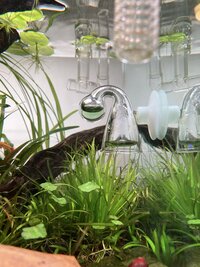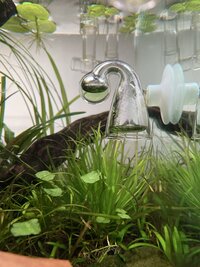Hey everyone!
Thanks for your replies and advice so far, I really appreciate it.
So I had a go at doing the PH profiling today. First off, here’s some general info of my co2 and light schedule…
My BPS is 1.
Co2 turns on at 08.00.
Lights turn on at 10.00 and are at full power (40% intensity) by 10:30. I’m using a Chihiros WRGB2.
Co2 turns off at 16:00.
Lights start to ramp down at 17:30 and are completely off by 18:00.
Here are the PH readings from today:
08.00 7.2
10:30 6.9
11:30 6.9
12:30 6.8
13:30 6.8
14:40 6.8
15:45 6.7
17.00 6.8
18:00 6.9
From this, my understanding is that I need to increase my co2 amount (upping the bps?) to make the PH drop lower faster? Or perhaps I need to make the co2 turn on even earlier?
I may have to redo this test again at the weekend as it’s a bit hard to periodically do the tests on the hour in between work meetings, but I was curious to get a rough idea of what my co2 today and it was interesting to see!
Thanks for your replies and advice so far, I really appreciate it.
So I had a go at doing the PH profiling today. First off, here’s some general info of my co2 and light schedule…
My BPS is 1.
Co2 turns on at 08.00.
Lights turn on at 10.00 and are at full power (40% intensity) by 10:30. I’m using a Chihiros WRGB2.
Co2 turns off at 16:00.
Lights start to ramp down at 17:30 and are completely off by 18:00.
Here are the PH readings from today:
08.00 7.2
10:30 6.9
11:30 6.9
12:30 6.8
13:30 6.8
14:40 6.8
15:45 6.7
17.00 6.8
18:00 6.9
From this, my understanding is that I need to increase my co2 amount (upping the bps?) to make the PH drop lower faster? Or perhaps I need to make the co2 turn on even earlier?
I may have to redo this test again at the weekend as it’s a bit hard to periodically do the tests on the hour in between work meetings, but I was curious to get a rough idea of what my co2 today and it was interesting to see!






